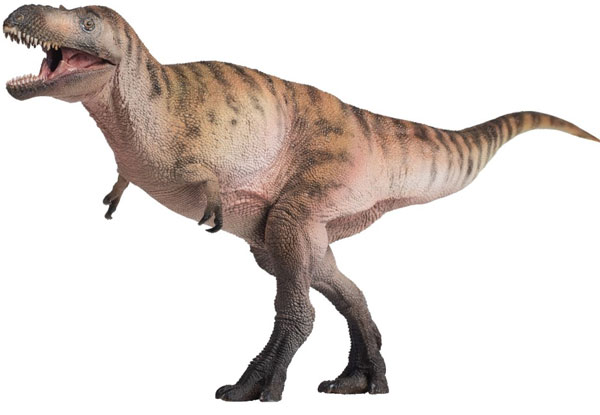Nanotyrannus Taxon Confirmed: A New Chapter in Tyrannosaur Evolution
For decades, palaeontologists have debated whether Nanotyrannus lancensis was a real species or simply a juvenile Tyrannosaurus rex. A new study, published in the journal “Nature” has solved this mystery. A remarkable fossil from the famous “Duelling Dinosaurs” discovery in Montana has confirmed that Nanotyrannus was indeed a distinct tyrannosaur species – not a teenage T. rex.
The fossil, unearthed in the Hell Creek Formation, captures a Triceratops and a small tyrannosaur preserved together. For years, scientists argued that the smaller predator was a young Tyrannosaurus rex. However, new research led by Lindsay Zanno of North Carolina State University demonstrates that this specimen represents a fully mature Nanotyrannus lancensis.
To read Everything Dinosaur’s blog post from 2020 about North Carolina State University acquiring the “Duelling Dinosaurs” specimen: “Duelling Dinosaurs” Get Permanent Home.
The researchers studied the tyrannosaur’s histology, bone fusion and anatomical development. They determined that this dinosaur was around twenty years old when it perished. This was not a juvenile T. rex after all.

The snout of Nanotyrannus lancensis from the “Duelling Dinosaurs” specimen. Picture credit: North Carolina State University.
Picture credit: North Carolina State University
Late Cretaceous North American Tyrannosaur Diversity
Significantly, the fossil skeleton shows traits that cannot be explained by growth alone. It had proportionally longer forelimbs, more teeth, fewer tail vertebrae, and distinctive skull nerve canals. Such features appear early in development and remain constant throughout life.
Co-author James Napoli (Stony Brook University, New York), explained:
“For Nanotyrannus to be a juvenile T. rex, it would have to break every known rule of vertebrate growth. It’s simply impossible.”

The researchers discovered that the forearm and hand of Nanotyrannus was different to that of Tyrannosaurus rex. Picture credit: NC Museum of Natural Sciences.
Picture credit: NC Museum of Natural Sciences
Sitting Outside the Tyrannosauridae
Tyrannosaurus rex is among the most comprehensively studied extinct tetrapods. It was one of the last surviving non-avian dinosaurs. This species provides insights into Late Cretaceous terrestrial diversity, ecosystem structure and biogeographic exchange immediately preceding the end-Cretaceous mass extinction event. This new study changes how palaeontologists perceive tyrannosaur diversity. Instead of a single species dominating predatory niches, there were multiple predators co-existing in the Late Cretaceous of North America.
Over two hundred tyrannosaur fossils were examined. The team discovered another specimen with subtle differences from Nanotyrannus lancensis. The specimen known as “Jane” (BMRP 2002.4.1) at the Burpee Museum of Natural History Illinois represents a larger species of Nanotyrannus. A second Nanotyrannus species was erected by the researchers – Nanotyrannus lethaeus. The species epithet was inspired by the River Lethe of Greek mythology, symbolising how this new species remained hidden for decades.
The confirmation of Nanotyrannus as a valid genus suggests the final few million years of the Cretaceous were far more dynamic than once thought. Several tyrannosaur species, not just T. rex, co-existed. While Tyrannosaurus rex dominated with power and size, Nanotyrannus excelled in speed and agility, filling a different ecological niche.
Fellow co-author Lindsay Zanno, (associate research professor at North Carolina State University) added:
“This discovery paints a richer, more competitive picture of the last days of the dinosaurs.”
Picture credit: Anthony Hutchings
Phylogenetic analysis demonstrates that the two Nanotyrannus species sits outside the Tyrannosauridae family. Nanotyrannus and its close relatives belong to a distinct tyrannosaur lineage, one that is not closely related to T. rex. However, the taxonomic position of this genus remains uncertain. It has been speculated that the formation of the Western Interior Seaway separated theropod populations and this may have resulted in two, dissimilar lineages evolving.
Nanotyrannus Models
Despite the controversy, a number of Nanotyrannus figures have been made available for collectors. For example, Safari Ltd have made a Nanotyrannus figure and in 2021 PNSO introduced “Logan the Nanotyrannus” model.
To see the range of PNSO prehistoric animal figures in stock: PNSO Age of Dinosaurs Models and Figures.
Nanotyrannus lancensis and Nanotyrannus lethaeus
The findings outlined in the paper are not without controversy. Many authors who have questioned the validity of Nanotyrannus have accepted the study’s conclusions. However, debate remains over the taxonomy and whether the Burpee Museum specimen “Jane” really does represent a separate species of Nanotyrannus. With Nanotyrannus lancensis recognised, palaeontologists can now revisit long-held ideas about tyrannosaur evolution. For example, this new research will need to a reassessment of tyrannosaur growth rates.
Everything Dinosaur acknowledges the assistance of a media release from North Carolina State University in the compilation of this article.
The scientific paper: “Nanotyrannus and Tyrannosaurus coexisted at the close of the Cretaceous” by Lindsay E. Zanno and James G. Napoli published in Nature.
The Everything Dinosaur website: Prehistoric Animal Models and Figures.



